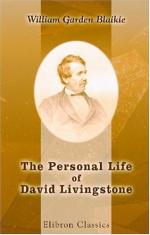It is not our object to follow Dr. Livingstone into all the details of his Expedition, but merely to note a few of the more salient points, in connection with the opportunities it afforded for the achievement of his object and the development of his character. It may he well to note here generally how the years were occupied. The remainder of 1858 was employed in exploring the mouths of the Zambesi, and the river itself up to Tette and the Kebrabasa Rapids, a few miles beyond. Next year—1859—was devoted mainly to three successive trips on the river Shire, the third being signalized by the discovery of Lake Nyassa. In 1860 Livingstone went back with his Makololo up the Zambesi to the territories of Sekeletu. In 1861, after exploring the river Rovuma, and assisting Bishop Mackenzie to begin the Universities’ Mission, he started for Lake Nyassa, returning to the ship toward the end of the year. In 1862 occurred the death of the Bishop and other missionaries, and also, during a detention at Shupanga, the death of Mrs. Livingstone: in the latter part of the year Livingstone again explored the Rovuma. In 1863 he was again exploring the Shire Valley and Lake Nyassa, when an order came from Her Majesty’s Government, recalling the Expedition. In 1864 he started in the “Lady Nyassa” for Bombay, and thence returned to England.
On the 1st May, 1858, the “Pearl” sailed from Simon’s Bay, and on the 14th stood in for the entrance to the Zambesi, called the West Luabo, or Hoskins’s Branch. Of their progress Dr. Livingstone gives his impressions in the following letter to his friend Mr. James Young:




